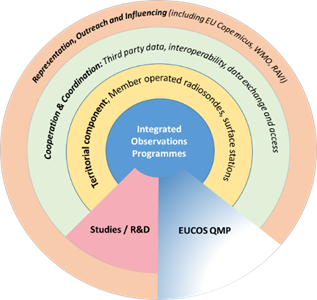OBSERVATIONS CAPABILITY AREA
Introduction
The EUMETNET Observations Capability Area (Obs CA) is responsible for operating and developing the EUMETNET Composite Observing System (EUCOS) which in turn forms a major regional contribution of the WMO Integrated Global Observing System (WIGOS). Originally created as an operational network in 2002, EUCOS established a collaborative network across much of Europe with the aim of optimising surface (non-satellite) observations activities to improve the quality and cost effectiveness of Numerical Weather Prediction (NWP) at a European scale and to provide a ‘backbone’ observing system to support wider application areas. More specifically EUCOS responded to the need to address the relatively poor coverage of observations over the North Atlantic compared to that over the territory of member National Met Services (NMSs).
EUCOS proved to be a great success, and today the EUMETNET Observations Capability Area is a mature activity, providing a collaborative framework for Member NMSs to address their shared observational needs. The scope of the activities has been expanded as the objectives of the programme have grown to encompass the observing needs for all forecast timescales, from climate to nowcasting, with a particular focus on convective scale, high impact weather.
Observations Capability Area
The Observations Capability Area offers a framework for EUMETNET Member NMSs to collaborate on activities in the field of Observing Systems. It is currently responsible for the operation of six Programmes (E-ABO, E-ASAP, E-GVAP, E-PROFILE, E-SURFMAR and OPERA) which have the primary task of operationally delivering observations of the atmosphere and near surface weather. Collectively they form a substantial proportion of European surface observing capability.
In addition to these operational programmes, the EUMETNET Observations Capability Area also provides;
The UK Met Office, working together with the German weather service (Deutscher Wetterdienst), is responsible for the EUMETNET Observations Capability Area. The Programme Manager is Jacqueline Sugier from the UK Met Office.
OBSERVATIONS – SCOPE & PURPOSE

For the new programme phase (2019 – 2023) the programme goals for the EUMETNET Observations Capability Area include two goals from the previous phase (O1, O2), which represent continuity, plus the addition of two new goals (O3, O4) responding to new needs and opportunities.
O1. EUMETNET will further develop a composite observing system for global, regional and increasingly kilometric scale forecasting, acknowledging the growing importance and specific needs of high-resolution models, and for Climate monitoring, building on existing infrastructure and in line with WIGOS principles.
O2. EUMETNET will ensure that observational and climate data gathered by the composite observing system will be of appropriate quality to meet the requirements of Forecasting (including numerical weather prediction) at global but first regional and local scales (short and very short range), Nowcasting (including support to Aviation) and Climate Monitoring, by working with Members to share and implement best practice and methodologies within the system.
O3. By 2025 the collective endeavours conducted under the EUMETNET observation programme will have enabled its Members to provide a cost efficient, world-class, shared observation infrastructure that is significantly more interoperable within its user base as well as with outside stakeholders. Interoperability should be greatly improved not only between the Members (and beyond to RA VI) but also with other stakeholders and user communities. In line with the principles of WIGOS, greater engagement with third party data providers will increase the quantity of data exchanged and made available to members.
O4. Links with third parties shall be reinforced. This covers a wide range of issues including calibration/validation, aviation services, collaboration with non-EUMETNET members & WMO RAVI NMHSs and engagement with third party data provides including the private sector.


Figure 1 above illustrates the main component parts of the EUMETNET Observations Capability Area (Obs CA). The original core objective of the EUCOS Programme, to establish and operate an optimized EUMETNET Composite Observing System (EUCOS) remains at the heart of Programme. This is achieved primarily through the:
The evolution of the Obs CA continues to be informed by a Research & Development (R&D) Programme and observations quality assured by the EUCOS Quality Monitoring Portal (QMP) and associated network management activities.
Reflecting the future strategic direction of the NMHSs observing strategies, which depend on greater collaboration and engagement with 3rd party communities and the need to exchange more data, the activities of the Obs CA are evolving accordingly. Greater emphasis is being placed on cooperation, regional coordination, representation and outreach.
Cooperation and Coordination: Activities strengthening collaboration on observations across the EUMETNET Membership and with third parties, focussing on facilitating data exchange, implementing improved methods of observing and establishing more active collaborative working on areas of shared interest.
Representation, Outreach and Influencing: Recognising our continued dependence on the wider Global Observing System (GOS), obligations to comply with international policy and the growing number of stakeholders having an interest in observational data, strong international representation will remain essential. This will include engagement within WMO/WIGOS, the EU (through the Copernicus Insitu project and other mechanisms), non-EUMETNET NMHSs and WMO RAVI.

The main objectives of the EUMETNET Observations Capability Area Management Programme are:

The current phase of the Programme started in January 2019 and will last until the end of 2023.
The Coordinating Member is the UK Met Office. The Programme Manager is Jacqueline Sugier.